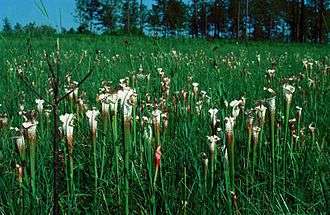Sarracenia leucophylla
| White pitcher plant | |
|---|---|
 | |
| Scientific classification | |
| Kingdom: | Plantae |
| (unranked): | Angiosperms |
| (unranked): | Eudicots |
| (unranked): | Asterids |
| Order: | Ericales |
| Family: | Sarraceniaceae |
| Genus: | Sarracenia |
| Species: | S. leucophylla |
| Binomial name | |
| Sarracenia leucophylla Raf. | |
 | |
| Sarracenia leucophylla range | |
| Synonyms | |
| |
Sarracenia leucophylla, also known as the crimson pitcherplant,[1] purple trumpet-leaf[2] or white pitcher plant, is a carnivorous plant in the genus Sarracenia.
Distribution
Like all the Sarracenia, it is native to North America. The species is endemic to the Southeastern United States. [3]
It inhabits moist and low-nutrient longleaf pine (Pinus palustris) savannas, primarily along the United States Gulf Coast, and generally west of the Apalachicola River on the Florida Panhandle. It is also found in Alabama, Georgia, Louisiana, Mississippi, and North Carolina. [3]
In North Carolina it has apparently been introduced by humans to areas outside its native range.[4]
Description
Sarracenia leucophylla has nodding, brownish-red flowers and clusters of erect, hollow, pitcher-like leaves. Each leaf is colored at top with reddish-purple veins on a white background and topped by an erect, roundish, wavy-edged hood. [5]
It is highly variable with respect to its height, with plants in some localities reaching almost 1 metre (3.3 ft) in height, while in others, plants can be diminutive. A seldom seen 30 centimetres (12 in) tall dwarf form is endemic to Garcon Point in Santa Rosa County, Florida.
- Flowers
The flowers are a slender, erect trumpet, 10–50 centimetres (3.9–19.7 in) tall and green veined with red. [5] The flowers are very fragrant, with the odor similar to English Violets (Viola odorata). [5]The plant produces characteristically small spring pitchers. These are generally followed midsummer with flat non-carnivorous leaves known as phyllodia. Its most robust and handsome pitchers are then produced in the early autumn.
Conservation
The plant is a listed vulnerable species on the IUCN Red List of Threatened Species. [6] The greatest threat to S. leucophylla, as is the case with most Sarracenia species, is loss of its unique wetland habitat to development along the Gulf Coast, as well as forest succession that was historically kept in check by natural wildfires.
It is also endangered from being one of the largest and showiest Sarracenia species, and is vulnerable to poachers of living plants and to the cut-floral trade for use in flower arrangements.
Cultivation
Sarracenia leucophylla is cultivated as an ornamental plant. [7] Despite its native range in the Southeastern U.S., it is remarkably hardy and can be grown outside even in USDA zones 6 and colder with careful winter protection. In cultivation it is generally less tolerant of stagnant water conditions and requires adequate soil drainage while still retaining requisite moisture levels to prevent root rot. [8]
Several clones are recognized:
- 'Schnell's Ghost', a yellow-flowered clone with little red in the pitchers (though not anthocyanin free)
- 'Hurricane Creek White', a group of predominantly white plants from Hurricane Creek, AL
- 'Tarnok', a mutant form which produces a showy, although sterile, double flower
- 'Titan', an especially tall and robust form that may produce fall pitchers greater than 38 inches (97 cm) in height.
Gallery
-

Sarracenia leucophylla
-

Sarracenia leucophylla flower
-

Field of S. leucophylla
-

Sarracenia leucophylla in cultivation
-

Sarracenia leucophylla at Liberec Botanical Garden, Czech Republic
References
- ↑ "Sarracenia leucophylla". Natural Resources Conservation Service PLANTS Database. USDA. Retrieved 6 November 2015.
- ↑ "BSBI List 2007". Botanical Society of Britain and Ireland. Archived from the original (xls) on 2015-02-25. Retrieved 2014-10-17.
- 1 2 USDA Distribution map for Sarracenia leucophylla
- ↑ Weakley, Alan S. Flora of the Southern and Mid-Atlantic States Working Draft of 30 November 2012.
- 1 2 3 Lady Bird Johnson Wildflower Center Native Plant Information Network−NPIN: Sarracenia leucophylla (Crimson pitcherplant)
- ↑ The IUCN Red List of Threatened Species: Sarracenia leucophylla
- ↑ D’Amato, Peter. 1998. The Savage Garden: Cultivating Carnivorous Plants. Ten Speed Press, Berkeley. ISBN 0-89815-915-6
- ↑ International Carnivorous Plant Society: Growing Sarracenia Leucophylla
External links
| Wikimedia Commons has media related to Sarracenia leucophylla. |
